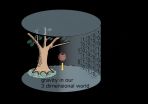How spacetime is built by quantum entanglement
New insight into unification of general relativity and quantum mechanics
2015-05-27
(Press-News.org) A collaboration of physicists and a mathematician has made a significant step toward unifying general relativity and quantum mechanics by explaining how spacetime emerges from quantum entanglement in a more fundamental theory. The paper announcing the discovery by Hirosi Ooguri, a Principal Investigator at the University of Tokyo's Kavli IPMU, with Caltech mathematician Matilde Marcolli and graduate students Jennifer Lin and Bogdan Stoica, will be published in Physical Review Letters as an Editors' Suggestion "for the potential interest in the results presented and on the success of the paper in communicating its message, in particular to readers from other fields."
Physicists and mathematicians have long sought a Theory of Everything (ToE) that unifies general relativity and quantum mechanics. General relativity explains gravity and large-scale phenomena such as the dynamics of stars and galaxies in the universe, while quantum mechanics explains microscopic phenomena from the subatomic to molecular scales.
The holographic principle is widely regarded as an essential feature of a successful Theory of Everything. The holographic principle states that gravity in a three-dimensional volume can be described by quantum mechanics on a two-dimensional surface surrounding the volume. In particular, the three dimensions of the volume should emerge from the two dimensions of the surface. However, understanding the precise mechanics for the emergence of the volume from the surface has been elusive.
Now, Ooguri and his collaborators have found that quantum entanglement is the key to solving this question. Using a quantum theory (that does not include gravity), they showed how to compute energy density, which is a source of gravitational interactions in three dimensions, using quantum entanglement data on the surface. This is analogous to diagnosing conditions inside of your body by looking at X-ray images on two-dimensional sheets. This allowed them to interpret universal properties of quantum entanglement as conditions on the energy density that should be satisfied by any consistent quantum theory of gravity, without actually explicitly including gravity in the theory. The importance of quantum entanglement has been suggested before, but its precise role in emergence of spacetime was not clear until the new paper by Ooguri and collaborators.
Quantum entanglement is a phenomenon whereby quantum states such as spin or polarization of particles at different locations cannot be described independently. Measuring (and hence acting on) one particle must also act on the other, something that Einstein called "spooky action at distance." The work of Ooguri and collaborators shows that this quantum entanglement generates the extra dimensions of the gravitational theory.
"It was known that quantum entanglement is related to deep issues in the unification of general relativity and quantum mechanics, such as the black hole information paradox and the firewall paradox," says Hirosi Ooguri. "Our paper sheds new light on the relation between quantum entanglement and the microscopic structure of spacetime by explicit calculations. The interface between quantum gravity and information science is becoming increasingly important for both fields. I myself am collaborating with information scientists to pursue this line of research further."
INFORMATION:
Paper
Authors: Jennifer Lin (1), Matilde Marcolli (2), Hirosi Ooguri (3,4), Bogdan Stoica (3)
Author affiliations: (1) Enrico Fermi Institute and Department of Physics, University of Chicago
(2) Department of Mathematics, California Institute of Technology
(3) Walter Burke Institute for Theoretical Physics, California Institute of Technology
(4) Kavli Institute for the Physics and Mathematics of the Universe (WPI), University of Tokyo
Title: Locality of Gravitational Systems from Entanglement of Conformal Field Theories
Journal: Physical Review Letters
Links
The University of Tokyo http://www.u-tokyo.ac.jp/en/
Kavli Institute for the Physics and Mathematics of the Universe http://www.ipmu.jp/
Research contact
Hirosi Ooguri
Principal Investigator
Kavli Institute for the Physics and Mathematics of the Universe, The University of Tokyo
Email: h.ooguri@gmail.com
Press officer contact
Motoko Kakubayashi
Project Specialist
Kavli Institute for the Physics and Mathematics of the Universe, The University of Tokyo
Tel: +81-4-7136-5980 (office)
Email: press@ipmu.jp
About the Kavli IPMU
Kavli IPMU (Kavli Institute for the Physics and Mathematics of the Universe) is an international research institute with English as its official language. The goal of the institute is to discover the fundamental laws of nature and to understand the Universe from the synergistic perspectives of mathematics, astronomy, and theoretical and experimental physics. The Institute for the Physics and Mathematics of the Universe (IPMU) was established in October 2007 under the World Premier International Research Center Initiative (WPI) of the Ministry of Education, Sports, Science and Technology in Japan with the University of Tokyo as the host institution. IPMU was designated as the first research institute within Todai Institutes for Advanced Study (UTIAS) in January 2011. It received an endowment from The Kavli Foundation and was renamed the "Kavli Institute for the Physics and Mathematics of the Universe" in April 2012. Kavli IPMU is located on the Kashiwa campus of the University of Tokyo, and more than half of its full-time scientific members come from outside Japan.
About the University of Tokyo
The University of Tokyo is Japan's leading university and one of the world's top research universities. The vast research output of some 6,000 researchers is published in the world's top journals across the arts and sciences. Our vibrant student body of around 15,000 undergraduate and 15,000 graduate students includes over 2,000 international students. Find out more at http://www.u-tokyo.ac.jp/en/ or follow us on Twitter at @UTokyo_News_en.
ELSE PRESS RELEASES FROM THIS DATE:
2015-05-27
ALNARP, SWEDEN -- In organic apple orchards, one of the most serious challenges for growers is determining ways to limit weed competition while improving soil quality and ensuring high yields of quality apples. Scientists from the Swedish University of Agricultural Sciences published a study of orchard floor management systems (HortScience, March 2015) that revealed the benefits of using "sandwich systems" in organic orchards.
Ibrahim I. Tahir, Sven-Erik Svensson, and David Hansson investigated different orchard management systems in an organic apple orchard adapted to ...
2015-05-27
Worldwide, obesity is becoming more prevalent. According to The World Health Organization, worldwide obesity has nearly doubled since 1980, and in 2008 25% of adults aged 20 and over were overweight, and another 11% were obese. Obesity has been identified as a major source of unsustainable health costs and numerous adverse outcomes, including morbidity and mortality due to hypertension, type 2 diabetes, cardiovascular diseases and certain types of cancer.
Accuracy of body weight perception is an individual's perception of their body weight (normal weight, overweight, ...
2015-05-27
About 2.5 billion people worldwide don't have access to sanitary toilets. Latrines are an option for many of those people, but these facilities' overwhelming odors can deter users, who then defecate outdoors instead. To improve this situation, fragrance scientists paired experts' noses and analytical instruments to determine the odor profiles of latrines with the aim of countering the offensive stench. Their report appears in the ACS journal Environmental Science & Technology.
Poor sanitation, including open defecation, is a major public health issue in many low-income ...
2015-05-27
Finding out what drugs can be used to treat a patient with tuberculosis (TB) can be can sped up by days or weeks, thanks to a new free online tool.
The new TB-Profiler tool, developed by a team of scientists led by Dr Taane Clark at the London School of Hygiene & Tropical Medicine, analyses and interprets genome sequence data to predict resistance to 11 drugs used for the treatment of TB. This rapid tool only takes a few minutes and means that sequence data can now be used without delay. Importantly, it also removes dependence on specialised bioinformatics skills that ...
2015-05-27
CORAL GABLES, Fla. (May 27, 2015) - Autism Spectrum Disorder (ASD) is a neurological condition that affects approximately two percent of people around the world. Although several genes have been linked to multiple concurring conditions of ASD, the process that explains how specific genetic variants lead to behaviors characteristic of the disorder remains elusive.
Now, researchers are utilizing animal models to understand how dysfunction of either of two genes associated with ASD, SYNGAP1 and SHANK 3, contributes to risk in ASD. The new findings pinpoint the actual place ...
2015-05-27
Every year, an estimated half-million Americans undergo surgery to have a stent prop open a coronary artery narrowed by plaque. But sometimes the mesh tubes get clogged. Scientists report in the journal ACS Nano a new kind of multi-tasking stent that could minimize the risks associated with the procedure. It can sense blood flow and temperature, store and transmit the information for analysis and can be absorbed by the body after it finishes its job.
Doctors have been implanting stents to unblock coronary arteries for 30 years. During that time, the devices have evolved ...
2015-05-27
One way to help the elderly cross what's known as the "digital divide" is the use of tablets, those smaller, lighter, easy-to-use computers that seem to be taking the place of laptops.
New Michigan State University research has found that the use of tablets does make it easier, breaking down some of the barriers that keep seniors from getting connected.
In addition to being smaller, lighter and more portable, tablets allow people to maneuver online without having to move and click a mouse.
"The dexterity required to control a mouse is really hard for some older adults," ...
2015-05-27
An international team of astronomers, including researchers from the University of Cambridge, has identified a young planetary system which may aid in understanding how our own solar system formed and developed billions of years ago.
Using the Gemini Planet Imager (GPI) at the Gemini South telescope in Chile, the researchers identified a disc-shaped bright ring of dust around a star only slightly more massive than the sun, located 360 light years away in the Centaurus constellation. The disc is located between about 37 and 55 Astronomical Units (3.4 - 5.1 billion miles) ...
2015-05-27
The DNA encoding all life on Earth is made of four building blocks called nucleotides, commonly known as "letters," that line up in pairs and twist into a double helix. Now, two groups of scientists are reporting for the first time that two new nucleotides can do the same thing -- raising the possibility that entirely new proteins could be created for medical uses. Their two studies appear in ACS' Journal of the American Chemical Society.
Synthetic biologists have been attempting for years to expand on nature's genetic "alphabet," consisting of the nucleotide bases cytosine, ...
2015-05-27
With summer nearly here, U.S. consumers might think they have an abundance of sunscreen products to choose from. But across the Atlantic, Europeans will be slathering on formulations that manufacturers say provide better protection against the sun's damaging rays -- and skin cancer -- than what's available stateside, according to an article in Chemical & Engineering News (C&EN), the weekly newsmagazine of the American Chemical Society.
Marc S. Reisch, a senior correspondent at C&EN, reports that sunscreens on the U.S. market do protect users from some ultraviolet-A and ...
LAST 30 PRESS RELEASES:
[Press-News.org] How spacetime is built by quantum entanglement
New insight into unification of general relativity and quantum mechanics


